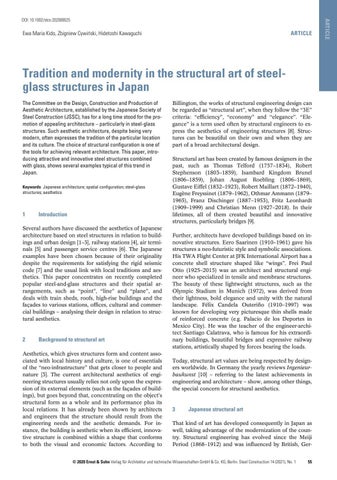ARTICLE
Ewa Maria Kido, Zbigniew Cywiński, Hidetoshi Kawaguchi
ARTICLE
DOI: 10.1002/stco.202000025
Tradition and modernity in the structural art of steelglass structures in Japan The Committee on the Design, Construction and Production of Aesthetic Architecture, established by the Japanese Society of Steel Construction (JSSC), has for a long time stood for the promotion of appealing architecture – particularly in steel-glass structures. Such aesthetic architecture, despite being very modern, often expresses the tradition of the particular location and its culture. The choice of structural configuration is one of the tools for achieving relevant architecture. This paper, introducing attractive and innovative steel structures combined with glass, shows several examples typical of this trend in Japan. Keywords Japanese architecture; spatial configuration; steel-glass structures; aesthetics
1 Introduction Several authors have discussed the aesthetics of Japanese architecture based on steel structures in relation to buildings and urban design [1–3], railway stations [4], air terminals [5] and passenger service centres [6]. The Japanese examples have been chosen because of their originality despite the requirements for satisfying the rigid seismic code [7] and the usual link with local traditions and aesthetics. This paper concentrates on recently completed popular steel-and-glass structures and their spatial arrangements, such as “point”, “line” and “plane”, and deals with train sheds, roofs, high-rise buildings and the façades to various stations, offices, cultural and commercial buildings – analysing their design in relation to structural aesthetics.
2
Background to structural art
Aesthetics, which gives structures form and content associated with local history and culture, is one of essentials of the “neo-infrastructure” that gets closer to people and nature [3]. The current architectural aesthetics of engineering structures usually relies not only upon the expression of its external elements (such as the façades of buildings), but goes beyond that, concentrating on the object’s structural form as a whole and its performance plus its local relations. It has already been shown by architects and engineers that the structure should result from the engineering needs and the aesthetic demands. For instance, the building is aesthetic when its efficient, innovative structure is combined within a shape that conforms to both the visual and economic factors. According to
00_STCO_0121_Buch.indb 55
Billington, the works of structural engineering design can be regarded as “structural art”, when they follow the “3E” criteria: “efficiency”, “economy” and “elegance”. “Elegance” is a term used often by structural engineers to express the aesthetics of engineering structures [8]. Structures can be beautiful on their own and when they are part of a broad architectural design. Structural art has been created by famous designers in the past, such as Thomas Telford (1757–1834), Robert Stephenson (1803–1859), Isambard Kingdom Brunel (1806–1859), Johan August Roebling (1806–1869), Gustave Eiffel (1832–1923), Robert Maillart (1872–1940), Eugène Freyssinet (1879–1962), Othmar Ammann (1879– 1965), Franz Dischinger (1887–1953), Fritz Leonhardt (1909–1999) and Christian Menn (1927–2018). In their lifetimes, all of them created beautiful and innovative structures, particularly bridges [9]. Further, architects have developed buildings based on innovative structures. Eero Saarinen (1910–1961) gave his structures a neo-futuristic style and symbolic associations. His TWA Flight Center at JFK International Airport has a concrete shell structure shaped like “wings”. Frei Paul Otto (1925–2015) was an architect and structural engineer who specialized in tensile and membrane structures. The beauty of these lightweight structures, such as the Olympic Stadium in Munich (1972), was derived from their lightness, bold elegance and unity with the natural landscape. Félix Candela Outeriño (1910–1997) was known for developing very picturesque thin shells made of reinforced concrete (e.g. Palacio de los Deportes in Mexico City). He was the teacher of the engineer-architect Santiago Calatrava, who is famous for his extraordinary buildings, beautiful bridges and expressive railway stations, artistically shaped by forces bearing the loads. Today, structural art values are being respected by designers worldwide. In Germany the yearly reviews Ingenieurbaukunst [10] – referring to the latest achievements in engineering and architecture – show, among other things, the special concern for structural aesthetics.
3
Japanese structural art
That kind of art has developed consequently in Japan as well, taking advantage of the modernization of the country. Structural engineering has evolved since the Meiji Period (1868–1912) and was influenced by British, Ger-
© 2020 Ernst & Sohn Verlag für Architektur und technische Wissenschaften GmbH & Co. KG, Berlin. Steel Construction 14 (2021), No. 1 55
03.02.21 11:16





